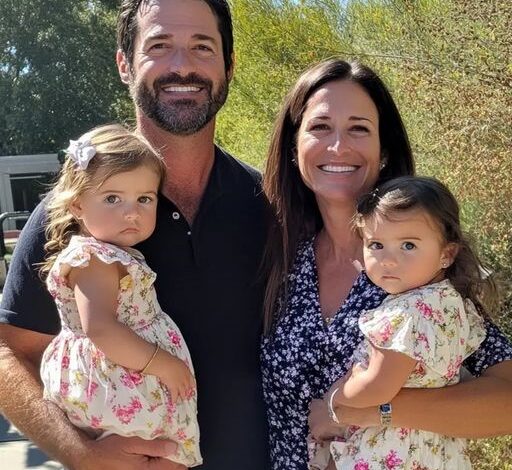
The funeral was unbearable. Our daughters, Sophie and Emma, only four and five years old, kept asking, “Where’s Mommy?” I had no idea how to answer. How could I explain something I didn’t understand myself? Thankfully, Elizabeth’s parents and sister were there to help handle the arrangements.
After the service, as I walked to my car in a daze, I felt someone watching me. At first, I thought it was just my grief playing tricks on me, but then I saw her—an old woman standing near the cemetery gates.
She looked ancient, her face etched with deep lines, her sharp eyes piercing through me as if she could see straight into my soul.
“Excuse me,” she called softly.
I hesitated but didn’t respond. I was too drained for conversation, especially with a stranger.
“I know your fate,” she said, her voice serious.
I frowned. “What?”
“Cross my palm with silver, and I’ll reveal the joy and sorrow that lie ahead,” she continued, holding out her hand.
I stared at her, bewildered. A fortune-teller? At a funeral? I shook my head, muttering, “I’m not interested,” and started to walk away.
But her next words stopped me cold. “Elizabeth won’t rest until justice is served.”
I turned back sharply. “What did you say?”
“Twenty dollars,” she said, beckoning with her bony fingers. “That’s all.”
Under normal circumstances, I would’ve dismissed her. But in my grief-stricken state, I was numb to everything. Twenty dollars seemed insignificant in the grand scheme of things. I handed her the crumpled bill.
Her hand felt icy as she grabbed mine, her grip surprisingly firm. She didn’t take her eyes off me, and for a moment, I felt exposed, as though she could see all the pain I was carrying.
“Today, you’ve lost someone dear,” she whispered.
“Yeah, no kidding,” I said bitterly. “We’re at a cemetery.”
She didn’t flinch. “Your wife’s death was no accident.”
A chill ran down my spine. “What are you talking about?”
“There’s more to her death than you know. Tomorrow, the truth will begin to reveal itself.”
I felt my mouth go dry. “What truth?”
She smiled slowly, an unsettling grin. “By this time tomorrow, you’ll see.”
Before I could ask anything else, she turned and disappeared into the mist, vanishing as if she had never been there. I stood frozen, torn between disbelief and a strange sense of foreboding.
That night, I couldn’t sleep. Every time I closed my eyes, I saw Elizabeth—her smile, her laugh, the way she kissed our daughters goodnight. But the fortuneteller’s cryptic words haunted me: “Your wife’s death was no accident.” Was there any truth to it? Could the crash have been something more sinister?
Unable to rest, I got up and sifted through Elizabeth’s things, desperate to feel close to her. Among her belongings, I found something odd—receipts from a car rental service. We had two cars. Why would she need a rental?
I stared at the receipts, my heart racing. The fortuneteller’s words echoed in my mind. “There’s more to her death than you know.”
The next morning, I couldn’t shake the feeling that something was terribly wrong. I called Elizabeth’s best friend, Sarah, who worked at the garage where our cars were serviced. Maybe she could help me make sense of it all.
“Hey, Sarah,” I said, trying to keep my voice steady. “Did Elizabeth mention anything to you about renting a car?”
There was a brief pause before she answered. “Actually, yes. She rented a car when both of your cars were in the shop. It was for a surprise trip to the beach, but she returned it the day before… well, you know.”
“But why didn’t she tell me?” I muttered to myself.
“She wanted it to be a surprise,” Sarah replied. “She even asked her sister Karen to return the car for her after the trip.”
A wave of unease washed over me. Karen? Why would she return the car, and why hadn’t I known about it?
Determined to get answers, I drove to the rental company. When I explained the situation, the manager pulled up the records. “The car was returned without visible damage. We accepted it as normal, but… something seems off. Only a few miles were added to the odometer.”
I left the office with more questions than answers. Why had Karen returned the car? What was she hiding? I decided to contact the police, as the suspicion that Elizabeth’s death wasn’t an accident gnawed at me.
I explained everything to the detective—the car rental, the fortuneteller, my growing doubts. He listened carefully and assured me they’d investigate. “Initially, we ruled it a tragic accident caused by brake failure,” he said. “But now, with what you’ve shared, we’ll take a closer look.”
The days that followed were a blur. Then, the police found something shocking—evidence that someone had tampered with the brakes. My stomach churned as the horrifying truth began to surface.
It wasn’t long before the investigation revealed even more. Karen had taken out a life insurance policy on Elizabeth just months before the accident. She had forged Elizabeth’s signature and made herself the sole beneficiary.
I was sickened. Elizabeth’s death hadn’t been an accident—it was murder. And the person behind it was her own sister.
When Karen was arrested, I couldn’t even look at her. The woman who had comforted me in my grief had been the one to cause it all, driven by greed.
During interrogation, she confessed to tampering with the car’s brakes, hoping to collect the insurance money. The betrayal was devastating.
Karen was sentenced to life in prison. It didn’t bring Elizabeth back, but at least I knew she would never harm anyone again. The fortuneteller had been right—Elizabeth couldn’t rest until justice was served.
A few weeks later, I returned to the cemetery. As I stood by Elizabeth’s grave, I whispered, “You can rest now.”
Just as I was about to leave, a butterfly landed on her headstone. I knew it was Elizabeth, finally at peace.
Though I never saw the fortuneteller again, her words had led me to the truth. As painful as it was, that truth was worth every penny of the twenty dollars I had given her.
“Go F–k Yourself” Elon Musk Is Never One To Pull Punches, Absolutely Unloads On Ad Boycott, Calls Out Disney CEO
Elon Musk is never one to pull punches, even when he’s in a good mood, and now that advertisers are boycotting X, he’s not in a good mood and is certainIy not pulling punches.

Such was obvious when, on Wednesday, Elon appeared at The New York Times’ DealBook/Summit with CNBC’s Andrew Ross Sorkin.
There, Elon directly confronted the group of companies engaging in the ad boycott of X, Go f -k yourself. That came when Elon was discussing the nature of the economic attack on X and argued, quite persuasiveIy, that it is coming to be difficult for them to threaten him, one of the wealthiest men on Earth, with money.
Speaking to Sorkin about the issue, Musk said, “I hope they stop. Don’t advertise. If somebody is going to try to blackmail me with advertising, blackmail me with money, go fuck yourself. Go f -k yourself. Is that clear? I hope it is.”
Elon then went on to single out Disney CEO Bob Iger, who said that he does not want Disney to be affiIiated with Musk and his comments and whose company stopped advertising on X. Directing his comment toward Iger, Musk said, Hey Bob, if you’re in the audience.
Musk also commented, during the event, on a tweet he made that some called anti-Semitic, saying, I shouId in retrospect should not have replied to that one person.
He added, Essentially I handed a loaded gun to those who hate me, and arguably to those are antisemitic, and for that I’m quite sorry. That was not my intention.



Leave a Reply